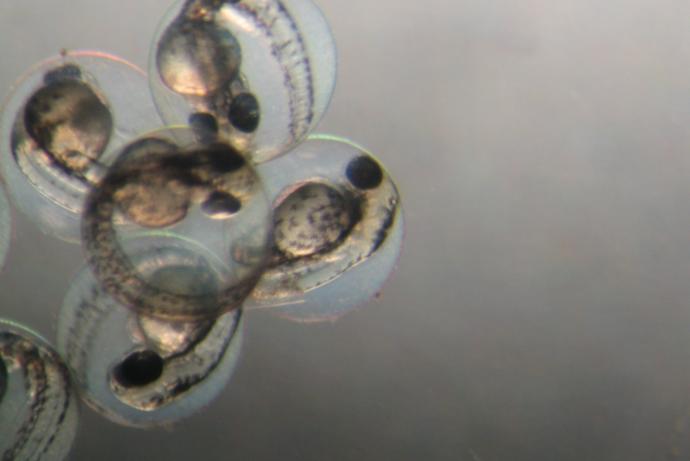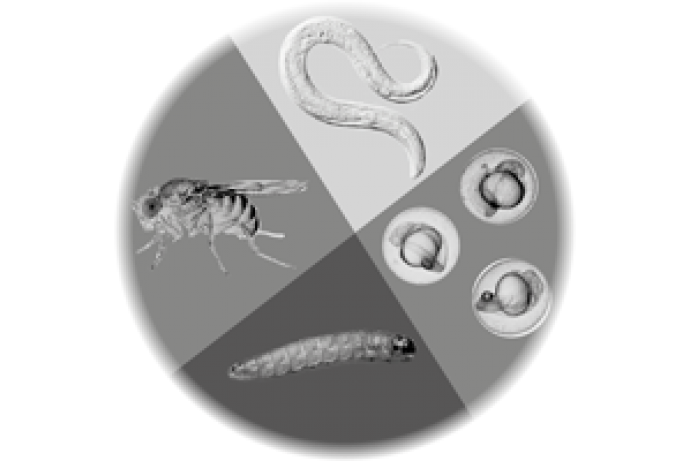CombiDART is a low-cost combinatorial approach that uses two non-vertebrate model systems to rapidly assess compounds for developmental and reproductive toxicity (DART). A library of fluorescent biomarkers has been developed in both organisms to facilitate phenotypic characterisation and molecular analysis of DART effects, thus pinpointing adverse outcome pathways (AOPs) and molecular initiating events (MIEs). The combinatorial approach increases predictive power and is intended to replace rat and rabbit use for compounds with high potential for DART, enabling their elimination early in product development. Industrial partners able to provide chemicals and expert guidance are sought to help validate CombiDART to meet their end-user needs.
The Solution providers have been awarded CRACK IT Solutions funding to work with the agrichemical company Syngenta to further validate CombiDART in an industrial setting. The project aims to demonstrate that the CombiDART model can provide DART alerts for new compounds early in the product development pipeline.
Regulations require that compounds released into the environment must first be tested for DART using OECD414 and 443 tests (assessing prenatal development toxicity and extended one-generation reproductive toxicity respectively) and these tests use many thousands of animals per year (Hartung and Rovida, 2009; Burden et al., 2015). Establishing the DART effects of new compounds in mammals is currently achieved by one or two generational tests in rats and/or rabbits. Use of single model organisms for identifying abnormalities caused by compounds is well established and medium to high throughput screening platforms have been described for analysing individual parameters such as number of progeny in C. elegans or chemotaxis in Dictyostelium (Harlow et al., 2016; Liao et al., 2016). A number of studies in both organisms have exploited the genetic tractability of the systems to provide information on the mechanism of action of single or small numbers of compounds, for example by identifying genes whose mutation or loss leads to resistance (Dent et al., 2000; Robery et al., 2013). However, these existing models using single organisms can lead to false negative/ positive results or organism-specific effects.
CombiDART rapidly assesses DART potential in two eukaryotic model organisms (the nematode C. elegans and the social amoeba Dictyostelium discoideum), as the combinatorial power increases the predictive value for mammalian DART. Both C. elegans and Dictyostelium are well-characterized, genetically tractable model organisms that share many features attractive for DART testing, including ease of manipulation and storage, short life cycle and low husbandry costs. Molecular pathways in both are well-conserved with mammals and both models have a history of success when used to study the mechanistic effects of compounds on molecular processes, especially development and reproduction (Dengg and van Meel, 2004; Burns et al., 2006; O'Reilly et al., 2014; Tillner et al., 1998; Li et al., 2000; Dannat et al., 2003; Harlow et al., 2016).
References:
- Burden N, Sewell F & Chapman K. (2015). Testing Chemical Safety: What Is Needed to Ensure the Widespread Application of Non-animal Approaches? PLoS Biol 13(5): e1002156. doi: 10.1371/journal.pbio.1002156.
- Burns AR, Kwok TC, Howard A, et al. (2006). High-throughput screening of small molecules for bioactivity and target identification in Caenorhabditis elegans. Nat Protoc 1(4): 1906-14. doi: 10.1038/nprot.2006.283.
- Dannat K, Tillner J, Winckler T, et al. (2003). Effects of medicinal compounds on the differentiation of the eukaryotic microorganism dictyostelium discoideum: can this model be used as a screening test for reproductive toxicity in humans? Pharmazie 58(3): 204-10. PMID:12685815.
- Dengg M. & Van Meel JC (2004). Caenorhabditis elegans as model system for rapid toxicity assessment of pharmaceutical compounds. J Pharmacol Toxicol Methods 50(3): 209-14. doi: 10.1016/j.vascn.2004.04.002.
- Dent JA, Smith MM, Vassilatis DK, et al. (2000). The genetics of ivermectin resistance in Caenorhabditis elegans. Proc Natl Acad Sci U S A 97(6): 2674-9. doi: 10.1073/pnas.97.6.2674.
- Harlow PH, Perry SJ, Widdison S, et al. (2016). The nematode Caenorhabditis elegans as a tool to predict chemical activity on mammalian development and identify mechanisms influencing toxicological outcome. Sci Rep 6: 22965. doi: 10.1038/srep22965.
- Hartung T & Rovida C (2009). Chemical regulators have overreached. Nature 460(7259): 1080-1. doi: 10.1038/4601080a.
- Li G, Alexander H, Schneider N, et al. (2000). Molecular basis for resistance to the anticancer drug cisplatin in Dictyostelium. Microbiology 146(Pt 9): 2219-27. doi: 10.1099/00221287-146-9-2219.
- Liao XH, Meena NP, Southall N, et al. (2016). A High-Throughput, Multi-Cell Phenotype Assay for the Identification of Novel Inhibitors of Chemotaxis/Migration. Sci Rep 6: 22273. doi: 10.1038/srep22273.
- O'reilly LP, Long OS, Cobanoglu MC, et al. (2014). A genome-wide RNAi screen identifies potential drug targets in a C. elegans model of alpha1-antitrypsin deficiency. Hum Mol Genet 23(19): 5123-32. doi: 10.1093/hmg/ddu236.
- Robery S, Tyson R, Dinh C, et al. (2013). A novel human receptor involved in bitter tastant detection identified using Dictyostelium discoideum. J Cell Sci 126(Pt23): 5465-76. doi: 10.1242/jcs.136440.
- Tillner J, Nau H, Winckler T, et al. (1998). Evaluation of the Teratogenic Potential of Valproic Acid Analogues in Transgenic Dictyostelium discoideum Strains. Toxicol In Vitro 12(4): 463-9. doi: 10.1016/S0887-2333(98)00016-2.
CombiDART identifies high-risk compounds early in product development, prior to vertebrate testing, whilst also providing information on mechanism of action. The low cost, rapid 48-well plate based assays have been optimised to assess the whole developmental and reproductive cycle in the two organisms, rather than analysing individual parameters. Libraries of C. elegans and Dictyostelium strains expressing easily scorable fluorescent proteins have been established, which act as surrogate markers for developmental stage, tissues and molecular pathways. This provides mechanistic information on the molecular and/or pathway target of compounds and will facilitate rapid quantification of dose responses. Rapid assessment of DART effects by fluorescence microscopy and easy visualisation of abnormalities in affected tissues, provides information on the mechanism of DART to inform product development. Results are evaluated from the two organisms, so pathways absent in one organism can often be detected in the other. Thus, it is hypothesised that the combinatorial approach will reduce false negative results as well as identify organism-specific effects, reducing the risk of false positives. The assay has also been adapted to enable hydrophobic compounds to be assessed and the test organisms optimised to maximise sensitivity to a wide range of compounds (Xiong et al., 2017).
There are a number of ways in which CombiDART could be developed as a commercial solution. These include, but are not limited to:
- Increasing the throughput and reducing the scale to enable rapid and cost-effective screening of large chemical libraries. This could include automation of plating and assessment of fluorescent marker expression (quantitation and/or localisation).
- Mode of action studies for compounds of interest using genetic approaches. This could include identification and characterisation of resistance mechanisms in the two organisms by standard screening procedures. Genetic changes that cause resistance in both organisms would be strong candidates for causing resistance in mammals. Shared resistance to different compounds would predict a common pathway target.
- Developing a novel set of markers in the two organisms for a particular pathway or compound set of interest. This would enable rapid analysis of related compounds to identify those lacking DART effects or conversely provide information on the mechanisms of action of related compounds.
References:
- Xiong H, Pears C & Woollard A (2017). An enhanced C. elegans based platform for toxicity assessment. Sci Rep 7(1): 9839. doi: 10.1038/s41598-017-10454-3.
CombiDART would benefit greatly from input from industrial partners to provide advice on the most commercially useful way(s) to develop the solution, including detail on how end users would prefer to adopt the screen (as an in-house screen, outsourced, etc.). Other inputs would depend on the use of the solution but could include:
- Provision of a collection of compounds with known DART effects in mammals and/or molecular or pathway targets (and negative controls) to refine the combinatorial assay system.
- Highlighting pathways of interest (to the partner) that could be used to inform the generation of specific biomarkers or genetic modifications in C. elegans and Dictyostelium to facilitate pathway analysis. For example, assessment of the phenotypes in both organisms caused by genetic disruption of defined MIEs or AOPs or generation of strains resistant/sensitive to AOP disruption to facilitate target screening.
- Expertise in automation of screening and access to necessary equipment such as robotic plating systems or automated assessment (or quantification) of marker expression for assay optimisation.
In return, this collaboration could:
- Validate a testing strategy that the industrial collaborators could apply to new compounds, thus identifying high risk compounds prior to testing in vertebrates.
- Generate new insights into mode of action for selected compounds.
- Adapt the Solution for specific chemical classes or detection of pathways/phenotypes of interest.
In 2010, over 20,000 animals were used for DART testing (Hartung and Rovida, 2009; Burden et al., 2015). An OECD414 test for prenatal development requires around 800 rats (900 rabbits for a second species) and extended tests (OECD443) require at least 1,400 rats per chemical. Toxicity can be delayed and effects therefore studied on the next generation. Developmental consequences can be severe and analysis invasive, leading to animal suffering. CombiDART provides a primary screen to identify chemicals with high potential for mammalian DART, facilitating compound removal before vertebrate testing. Each compound removed before OECD tests will reduce the number of animals used in DART assessments by approximately 2000. The percentage of compounds that will show DART in the CombiDART screen cannot currently be predicted but there is potential to reduce the number of animals by many thousands.
Current regulatory legislation means that chemicals with low DART potential in CombiDART have to be tested in mammals prior to approval. However, wider uptake of CombiDART will increase the weight of evidence for, in the longer term, completely replacing animals for testing. This will require demonstration of the predictive power of the combinatorial approach over a wide range of chemicals. Increased understanding of pathway perturbations underlying DART will strengthen this approach.
References:
- Burden N, Sewell F & Chapman K. (2015). Testing Chemical Safety: What Is Needed to Ensure the Widespread Application of Non-animal Approaches? PLoS Biol 13(5): e1002156. doi: 10.1371/journal.pbio.1002156.
- Hartung T & Rovida C (2009). Chemical regulators have overreached. Nature 460(7259): 1080-1. doi: 10.1038/4601080a.
Overview
Through CRACK IT Solutions, industrial partners were sought to further validate CombiDART. The researchers at the University of Oxford partnered with Syngenta, and with support of funding from the scheme, aim to demonstrate that the CombiDART model can provide DART alerts for new compounds early in the product development pipeline. Syngenta will provide compounds with known teratogenic potential in rats, rabbits and zebrafish to run in the CombiDART assay; evaluating the efficacy of the CombiDART model in an industrial setting.
If successful, CombiDART will provide a primary screen to identify chemicals with high potential for mammalian DART, facilitating compound removal before vertebrate testing. Each compound removed before OECD tests will reduce the number of animals used in DART assessments by approximately 4500. The percentage of compounds that will show DART in the CombiDART screen cannot currently be predicted but there is potential to reduce the number of animals by many thousands.




